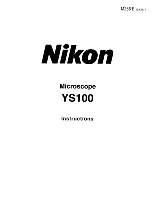
Page 9
Using a binocular (or trinocular) tube is less tiring for the eyes than the use of a monocular tube. In
order to obtain a smooth “compound” image, one should go through the below steps.
The correct interpupillary distance is reached when one round image is seen in the field of view
(see image below). This distance can be set by either pulling the tubes towards each other or
pulling them from each other. This distance is different for each observer and thus should be set
individually. When more users are working with the microscope it is recommended to remember
your interpupillary distance for a quick set up during new microscopy sessions. The iScope’s
swiveling eyepiece tube can be rotated 360º. You can select corresponding eye point height
according to your own preference.
Field of view before
Field of view after
adjustment
adjustment
The correct eye point
The eye point is the distance from the eyepiece to the user’s pupil. To obtain the correct eye
point, move the eyes towards the eyepieces until a sharp image is reached at a full field of view.
Adjusting the diopter
Using a binocular (or trinocular) tube is less tiring for the eyes than the use of a monocular tube. In
order to obtain the right interpupillary setting, one should go through the below steps.
Turn the diopter adjustment ring of the left eyepiece tube until the scale shows the same
reading as on the indicator.
Close the right eye and focus the left tube by means of the coarse- and fine adjustment knobs
Close the left eye and focus the right tube with the diopter adjustment ring.
This procedure should be followed by each individual user. When more users are working with the
iScope microscope it is recommended to remember your diopter setting for a quick set up during
new microscopy sessions.
Abbe condenser
Beneath the object stage an Abbe condenser N.A. 12.5 is mounted. The condenser can be adjusted
in height by means of a rack and pinion movement and knob. With this one can focus the light on





























